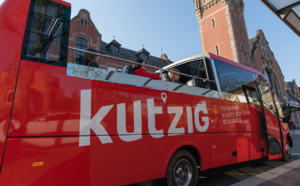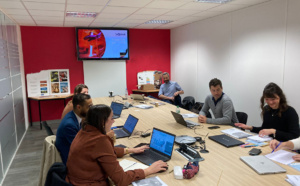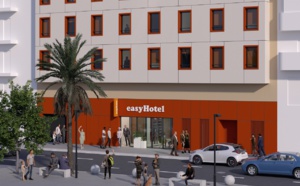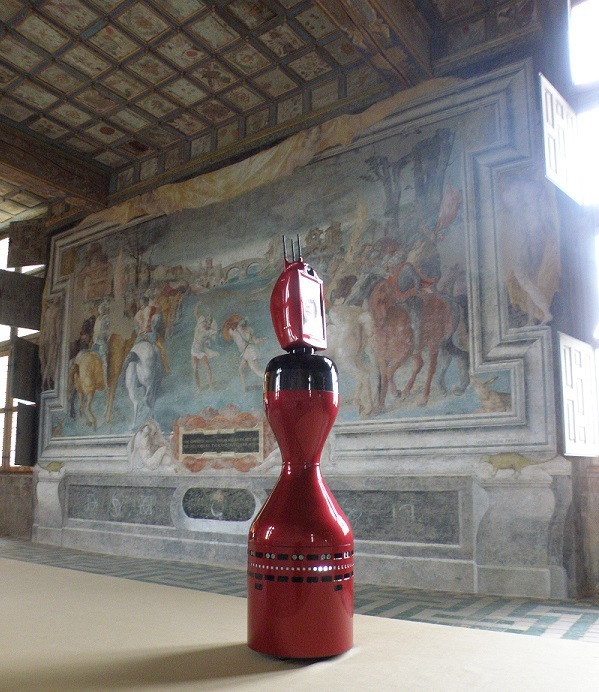
Norio, the unusual resident of the Oiron Castle
To make this evolution more concrete, and to understand the value of these humanoids in the tourism sector, let’s meet Norio.
He lives in the Oiron Castle, a landmark national monument, in the Deux-Sèvres department in France.
He is very knowledgeable in the field of Renaissance, 17th century and contemporary art. And, thanks to him, people who previously could not enjoy such art pieces, can now discover them.
He “haunts” the castle since November 2013. He “resides” on the first floor of this 16th century building.
While the ancestors of this monument would have never imagined his coming, today no one wants to see him go.
However there have been reluctances.
But in the end, Norio’s presence brings a lot.
Thanks to him, visitors with reduced mobility can visit the second floor of the Oiron Castle. Because of course, there is no elevator in the castle.
Created to move amongst the rooms of the second floor, the Oiron Castle robot, a first of its kind, enables disabled visitors to have control over the conditions of their visit.
The fathers of this project are the agents of the Oiron Castle and two robot engineers from the young company “Droïds Company.”
He lives in the Oiron Castle, a landmark national monument, in the Deux-Sèvres department in France.
He is very knowledgeable in the field of Renaissance, 17th century and contemporary art. And, thanks to him, people who previously could not enjoy such art pieces, can now discover them.
He “haunts” the castle since November 2013. He “resides” on the first floor of this 16th century building.
While the ancestors of this monument would have never imagined his coming, today no one wants to see him go.
However there have been reluctances.
But in the end, Norio’s presence brings a lot.
Thanks to him, visitors with reduced mobility can visit the second floor of the Oiron Castle. Because of course, there is no elevator in the castle.
Created to move amongst the rooms of the second floor, the Oiron Castle robot, a first of its kind, enables disabled visitors to have control over the conditions of their visit.
The fathers of this project are the agents of the Oiron Castle and two robot engineers from the young company “Droïds Company.”
How does Norio work?
Autres articles
-
 Travel Europe: England and Scotland new targets for 2016
Travel Europe: England and Scotland new targets for 2016
-
 Travel Europe : l'Angleterre et l'Ecosse en ligne de mire en 2016
Travel Europe : l'Angleterre et l'Ecosse en ligne de mire en 2016
-
 The truffle is celebrated in Sarlat, medieval city and the capital of the Périgord Noir!
The truffle is celebrated in Sarlat, medieval city and the capital of the Périgord Noir!
-
 The Museum of Mankind (Musée de l’Homme) will open in October 2015
The Museum of Mankind (Musée de l’Homme) will open in October 2015
-
 Memorial tourism: Hundred year anniversary of WWI boosts visit rates of historical sites
Memorial tourism: Hundred year anniversary of WWI boosts visit rates of historical sites
From the “test point” set up at the entrance of the castle, visitors can control the mobile robot to make him tour different rooms through the use of a computer mouse and joystick.
Each “test-visitor” receives, live, an HD audio and video transmission of the robot’s journey.
The visitor can communicate, via the robot, with the people walking in the same spaces, friends, other tourists, or a guide of the Oiron Castle.
Meaning that it’s a lot more than just a virtual visit since it can be active and interactive.
This “telepresence robot” is a technological innovation that responds to the challenges of a moving machine in a historical monument opened to the public.
Each “test-visitor” receives, live, an HD audio and video transmission of the robot’s journey.
The visitor can communicate, via the robot, with the people walking in the same spaces, friends, other tourists, or a guide of the Oiron Castle.
Meaning that it’s a lot more than just a virtual visit since it can be active and interactive.
This “telepresence robot” is a technological innovation that responds to the challenges of a moving machine in a historical monument opened to the public.
A revolution in terms of accessibility
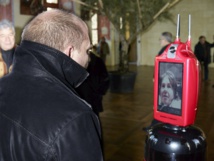
A visit that is both “distant” and “active”. Click to enlarge.
But it also constitutes a new type of offer that gives a more comprehensive visit to people who were previously restricted.
This first experience, on site, could probably be transposable to other historical monuments in the future.
Such as other museums or cultural sites where a complete and direct access is impossible to part and sometimes the whole public.
In the meantime, a small robot will be set up in the Azay-le-Rideau monument.
This first experience, on site, could probably be transposable to other historical monuments in the future.
Such as other museums or cultural sites where a complete and direct access is impossible to part and sometimes the whole public.
In the meantime, a small robot will be set up in the Azay-le-Rideau monument.
Discover Norio in video:
The birth of Norio of the Oiron Castle is fruit of multiple cooperations.
From the start, various public partnerships, engaged in a policy of accessibility of culture to all, wished to collaborate with the Center of National Monuments that initiated the project.
Therefore, the European Union, through the Leader unit (coordinated by representatives of the North of Deux-Sèvres), the Poitou-Charentes region and the Deux-Sèvres department have supported this innovation.
But because a mediation tool cannot be built without users, the Center of National Monuments and Droïds Company have regularly consulted with disabled people during the designing process.
Exchanges also took place between the team of the Oiron Castle, robot engineers, and members of the Deux-Sèvres delegation of the APF (Association of Paralyzed Individuals of France.)
Between 2011 and late 2012, the Center of National Monuments set up a Wi-Fi system in the Oiron Castle dedicated to controlling the future robot’s movements.
A complicated task
Simultaneously, Droïds Company was conducting laboratory research and was regularly experimenting on the site.
This joint work ended in November 2013 with the first commissioning inside the monument of the robot manufactured by Droïds Company.
Beyond this first use, the conception of the robot will undoubtedly enable to visit the Oiron Castle remotely in a few years.
In fact, the robot is directed from a computer thanks to dedicated wi-fi coverage.
Once a more developed internet connection will be established, a simple connection will enable to control the robot remotely, whether from a hospital or the house of sick child.
Therefore, the European Union, through the Leader unit (coordinated by representatives of the North of Deux-Sèvres), the Poitou-Charentes region and the Deux-Sèvres department have supported this innovation.
But because a mediation tool cannot be built without users, the Center of National Monuments and Droïds Company have regularly consulted with disabled people during the designing process.
Exchanges also took place between the team of the Oiron Castle, robot engineers, and members of the Deux-Sèvres delegation of the APF (Association of Paralyzed Individuals of France.)
Between 2011 and late 2012, the Center of National Monuments set up a Wi-Fi system in the Oiron Castle dedicated to controlling the future robot’s movements.
A complicated task
Simultaneously, Droïds Company was conducting laboratory research and was regularly experimenting on the site.
This joint work ended in November 2013 with the first commissioning inside the monument of the robot manufactured by Droïds Company.
Beyond this first use, the conception of the robot will undoubtedly enable to visit the Oiron Castle remotely in a few years.
In fact, the robot is directed from a computer thanks to dedicated wi-fi coverage.
Once a more developed internet connection will be established, a simple connection will enable to control the robot remotely, whether from a hospital or the house of sick child.
A forum on robotics
Within the scope of the European Week on Robotics, the AFEST and the think-tank Think Robotics organized a forum at the Welcome City Lab last November 27th.
There will be a series of articles to come around the following questions: Which robots for what types of services in tourism and leisure activities?
How should innovative French company position themselves on this topic?
There will be a series of articles to come around the following questions: Which robots for what types of services in tourism and leisure activities?
How should innovative French company position themselves on this topic?








